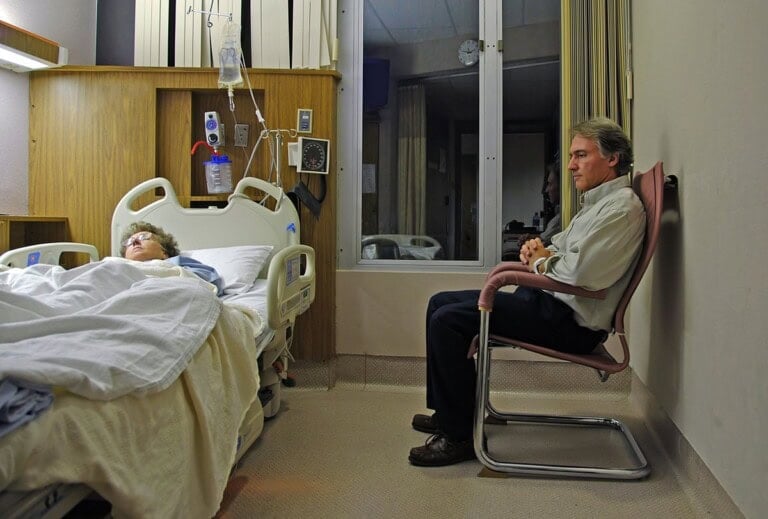What is Anxiety?
So what is anxiety exactly? Anxiety is the feeling of nervousness, discomfort, and fear in the face of stress or anticipation of a stressful situation.
Uneasiness, butterflies in the stomach, and dread are all symptoms of anxiety. It is a biological alarm in response to insecurity and it alerts the person of approaching danger.
Also see What is Agoraphobia!
History of anxiety
People living thousands of years ago have anxiety to thank for helping them intelligently avoid numerous life-threatening incidents.
Whether it was the hesitation before stepping into the rustling tall grass or staying put in their dwellings at night; fear and anxiety helped them avoid possible death.
Natural selection favored the ones with high levels of anxiety and fear as it helped them survive. Fast forward to the present, the descendants of these careful humans still experience similar anxiety.
Anxiety is also not restrained to only life-threatening situations. An everyday stressful situation can cause anxiety too.
Fear of losing a job, failing a test, or embarrassment of rejection can cause a lot more stress to people than the fear of being attacked by a wild beast solely because people find themselves in these situations more often.
Our brains try their best to avoid such stressful, embarrassing, and in some ways, dangerous situations, but sometimes it fails.
What is an anxiety disorder?
If a person experiences excessive and prolonged levels of anxiety and it starts affecting their normal life and hinders their daily functionality then it becomes a disorder.
Anxiety disorder is the most common type of mental health disorder. Unlike normal and relatively harmless anxiety, an anxiety disorder can last a lot longer and can show severe symptoms. It can also lead to other disorders like depression and panic attacks.
Anxiety from irrational fears
Anxiety and fear are closely related emotions. Fear activates within us a fight or flight response which helps us deal with threats.
Irrational fears are the exaggerated fears of things that pose little to no threat. These fears are typically called phobias and can generate a lot of anxiety in a person.
What makes them different from other forms of fear is that they remain persistent for more than 6 months and cause excessive fear of an object or a situation in a person.
All anxiety disorders have underlying irrational fears that fuel them. Fear and anxiety can lead to a mental disorder only if the mind is overly exaggerating the threat. Usually, the threat is non-existent.
There are many different types of phobias. Some of the most common phobias include:
- Social phobia
- Claustrophobia (fear of small enclosed spaces)
- Arachnophobia (fear of spiders)
- Acrophobia (fear of heights)
- Agoraphobia (fear of being in public places)
People suffering from phobias are usually aware of the irrationality of the fear but they cannot overcome it. They will go to great lengths to avoid being in such situations or avoid the object of fear.
For example, a person suffering from thalassophobia may avoid going near large bodies of water altogether. A person suffering from a social phobia may avoid public speaking forums or large social gatherings.
Symptoms of anxiety disorders
The most common symptoms of an anxiety disorder include:
- Panic
- Restlessness
- Anxiousness
- Increased heart rate
- Shortness of breath
- Dizziness
- Sweating
- Inability to concentrate
- Inability to think rationally
- Low blood pressure
- Weakness
- Gastrointestinal issues such as disturbed bowel movements, nausea
- Sleep deprivation
Types of anxiety disorders
There are several types of irrational fears or anxiety disorders. The most common ones include:
- Generalized anxiety disorder
- Obsessive-compulsive disorder
- Panic disorder
- Post-traumatic stress disorder
- Social anxiety disorder
Generalized anxiety disorder
People suffering from generalized anxiety disorder are not usually stressed about a single thing but about several different things over a long period of time.
They worry obsessively about their job, relationships, health, security, and many different things to the point where their everyday life is affected by it.
Patients find it extremely difficult to control their emotions or suppress their anxious thoughts. A person may be diagnosed with a generalized anxiety disorder if at least 3 or 4 of the symptoms mentioned above are experienced by them regularly for a long time and under different situations.
Around 3% of the USA’s population suffers from GAD. GAD affects people from all stages of life though it is more common in younger and middle-aged people and affects women more than men.
Obsessive-compulsive disorder
Obsessive-compulsive disorder is also a type of anxiety disorder where the patient finds himself trapped in the loop of obsession and compulsion.
Obsessions are unwanted intrusive thoughts or mental images that trigger stress and anxiety. The patient usually does not want to have these thoughts but is unable to stop thinking about them.
When the stress caused by the obsessions increase, the patient tries to relieve the stress or get rid of their obsessions by engaging in particular behaviors that are usually unhealthy.
Compulsions are directed towards relief from the stress caused by obsessions or to take the mind off of the obsessive thoughts.
What makes OCD different from regular compulsions such as nail-biting is that these activities and obsessive thoughts are very time-consuming and affect the daily life of the patient severely.
OCD makes the lives of patients very difficult. These compulsive behaviors are temporary solutions to obsessive thoughts but since the patient is unable to find a permanent solution, they stick to these behaviors.
1 percent of the US population is affected by OCD, with women being twice as susceptible to it as men.
Panic disorders
Panic disorders are the most severe form of anxiety disorders. Severe anxiety leads to panic attacks.
During a panic attack, the patient experiences high heart rate, heavy breathing, shortness of breath, sweating, chest pain, stomach pain, tremors, numbness, disturbed bowel movements, fainting, and intense feelings of fear and anxiousness.
The patient becomes avoidant different triggers that may cause panic attacks which can hamper their daily lives.
For example, situations such as exams or job interviews may cause extreme stress to a person and as the deadline approaches, the stress experienced by the person will increase. This prolonged stress can induce a panic attack and the person may suffer from a mental breakdown.
Panic attacks can last from 10-15 minutes to a couple of hours depending on the severity of the condition. The frequency of the attacks is also dependent on the severity of the condition of the person.
Usually, the cause of panic attacks is stressful life or childhood and imbalanced neurotransmitters. CPTSD or PTSD are major causes of continued panic attacks. 2.7% of the adult US population suffers from panic disorders.
Post-traumatic stress disorder (PTSD)
Post-traumatic stress disorders or PTSD for short, are another type of anxiety disorder. A person who has experienced a very traumatic and violent event or series of events in their lives usually suffers from PTSD.
A person suffering from PTSD may experience intrusive thoughts, usually something related to traumatic events, panic attacks, anxiety attacks, changes in mood and behavior, anger management issues, suicidal thoughts, feelings of detachment, and other self-destructive behavior.
Patients try to avoid talking about the traumatic event and try to avoid places, people, and other things that may bring back painful memories.
Symptoms of PTSD get worse over time and it is therefore important that help is sought as soon as possible. 6% of the US population at any given point in time suffers from PTSD.
Major treatment options are therapy and medication to suppress the symptoms.
Social anxiety disorder
Social anxiety disorder relates to an irrational fear of social gatherings and social settings. People suffering from social anxiety disorder find it very hard to meet new people or to actively take part in any kind of social gatherings and as with other anxiety disorders, try to avoid their triggers as much as possible.
Many will try to spend most of their time alone and will only have very few friends they interact with. They fear the judgment and critique of themselves by others, and usually avoid being the center of attention.
Social anxiety disorder is different from shyness. Shyness is temporary, but social anxiety disorder is long-lasting and deprives the patient of the everyday joys of social life. 7% of US adults suffer from a social anxiety disorder.
Though the cause of social anxiety disorder is unknown, bad life experiences can contribute significantly to increasing the severity of the symptoms and the disorder. The following can contribute to social anxiety disorder:
- Poor childhood
- Physical and sexual abuse
- Bullying
- Emotional abuse
- Parental or family abuse
- Long term family issues
- Emotional neglect
Treatments for anxiety disorders
A person suffering from any kind of anxiety disorder must see a general physician so that their anxiety disorder can be properly diagnosed.
Major treatments for anxiety disorders are medication and psychotherapy. A combination of both is usually preferred.
Medications
Medications don’t fully treat anxiety disorders but rather help control the symptoms and help the patient function normally.
Most common medications are:
- Anti-depressants: The most common anti-depressants prescribed for anxiety disorders are SSRIs. These are selective serotonin reuptake inhibitors.They treat anxiety and depression by increasing the levels of serotonin in the brain. They take up to 3-4 weeks to show signs of improvement.Therefore, it is advised that the medication is taken regularly even when the improvement is not apparent. Some side effects of using anti-depressants include fatigue, nausea, gastro-intestinal issues, insomnia, dry mouth, mood changes, and sexual dysfunction.
- Anti-anxiety medications: These mostly include benzodiazepines, also commonly known as tranquilizers. They help relieve symptoms of anxiety by slowing down the nervous system and calming the mind and the body.They take 30-60 minutes to show effects and are great for panic attacks and extreme anxiety episodes.Benzodiazepines are highly addictive as the body can build up a tolerance to them and need higher doses to be effective.This makes these medications susceptible to abuse. Therefore, they’re not prescribed for long-term use.
- Beta blockers: Though less common, beta-blockers are also prescribed for anxiety disorders. They help regulate blood pressure and help mitigate the physical symptoms of anxiety disorders such as tremors, shaking, and high blood pressure.
Therapy
Individual therapy such as CBT cognitive behavioral therapy and exposure therapy are the two most recommended and most effective treatments for anxiety disorders.
Though medication can help relieve the symptoms of anxiety, they are not the cure. Therapy can help people overcome their negative thought patterns and learn how to think more rationally when faced with an irrational fear.
Cognitive-behavioral therapy works by helping the patient recognize the thinking and behavioral patterns that lead to stress and anxiety and teaches the patient to slowly break those patterns and set themselves free.
A therapist guides the patient through the whole process and it usually takes a few weeks to several months or years.
CBT is a slow process. It takes time to become mindful of your destructive thought patterns and slowly breaking and changing those patterns.
In exposure therapy, the patient is slowly and gradually exposed to the situations or things that they have been avoiding to not feel anxiety.
The therapist helps the patient slowly come to terms with the irrationality of their fears and makes them realize how insignificant or non-existent the causes of those fears are.
Exercise and yoga
Experiments have shown that regular exercise can greatly help with the symptoms of anxiety disorders.
Exercise release endorphins in the body. Increased number of endorphins keeps the mood calm and overall happy.
Exercise and yoga are physical exercises that require focus and hard work. This helps in diverting the mind from obsessive thoughts and helps avoid unnecessary anxiety.
Self-help books
Self-help books have a bad reputation, but they can be very helpful in teaching different strategies that help people maintain healthy habits, prepare them for different challenges of life and help them cope with symptoms of anxiety.
Group therapy
Group therapies provide a platform where the patients can come together and collectively help each other.
Watching others make an effort and listening to their struggles and stories makes a patient realize that they’re not alone and have a lot of supporting individuals ready to guide the way.
So, what is anxiety?
Thousands of years ago, anxiety might have been helpful, but today, it can lead to a lot of stress and make it difficult for people to function and perform daily activities. There are different types of anxiety disorders and all of them affect people in different ways.
There are many treatment options available for people with anxiety. Therapy is the most effective method as it can change the way people think.
The main objective is to eliminate negative thought patterns so people with anxiety can feel better about themselves and see the irrationality behind their fears.
Other related articles
- 8 Life-Changing Benefits Of Exercise
- Sauna Benefits And Disadvantages
- What Makes You Gain Weight
- How To Boost Metabolism Naturally
- How To Lower Cholesterol Naturally
If you enjoyed this post, “What is Anxiety”, and would love to see more, join me on Youtube, Instagram, Facebook & Twitter!
Get discounted copies of my cookbook here.
Fortunately, because of the ads on our website, readers and subscribers of Healthier Steps are sponsoring many underprivileged families.








